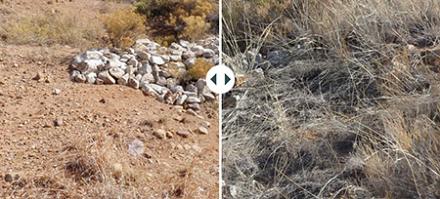Low-Tech Method Restores Eroded Lands

Watershed 6 Check Dam 30, November 2009 (left) and December 2020 (right). Photo courtesy of Southwest Watershed Research Center.
“A picture is worth a thousand words,” so the saying goes. Scientists with the Agricultural Research Service (ARS) Southwest Watershed Research Center in Tucson, AZ, took that saying to heart when they embarked on a project a decade ago to photograph the effectiveness of an ancient erosion-control technique.
“Check dams” are low barricades built of loosely piled rocks spanning modest-sized channels. The dams slow the rush of rainwater from sporadic downpours that carve deep gullies in the Southwest’s sandy soil. A check dam’s loose build lets water pass through slowly, but it also allows the dam to come apart in the event of excessive rainfall, to reduce the risk of flooding.
Conventional wisdom and centuries of use told the scientists that check dams worked in controlling erosion, but they wanted to demonstrate how well they worked. So they built check dams at 37 sites in two watersheds in the Santa Rita Mountains and photographed each site annually to document changes in the landscape over time.
The results are visually remarkable. In the study’s 10-year span, soil slowly refilled the eroded channels and plants grew back, providing food and habitat for wildlife and grazing animals. Ranchers who want to improve vegetation can couple this technique with seeding and runoff-water capture to encourage grass to grow in the areas between channels.
“Increased drought cycles like the Southwest has been experiencing are hard on grasses, and monsoon rain events have become more severe in the last decade, making the damage in the landscape even worse,” said ARS research hydraulic engineer Mary Nichols, who led the study. “Check dams are a low-tech, effective tool that can repair or at least limit some erosion damage and help build resiliency into landscapes.” She stresses that properly maintaining the check dams is essential to their effectiveness.
Check out the before-and-after photographs of the study sites and learn about the team’s research.
Check dams are being built not only in the Southwest, but across the globe. In Jordan, ARS researchers are collaborating with the U.S. Forest Service, the International Center for Agricultural Research in the Dry Area, and the Water And Development Initiative to build rock check dams to trap water and sediments and stop further deepening of gullies. These rock check dams, also called gully plugs, trap sediments and water and provide fertile ground for reestablishment of native species, which further trap sediments, slow water flows, and decrease erosive power of the running water. This technique has been added to the United Nation’s World Overview of Conservation Approaches and Technologies database of conservation approaches and technologies. —By Sue Kendall, ARS Office of Communications.

